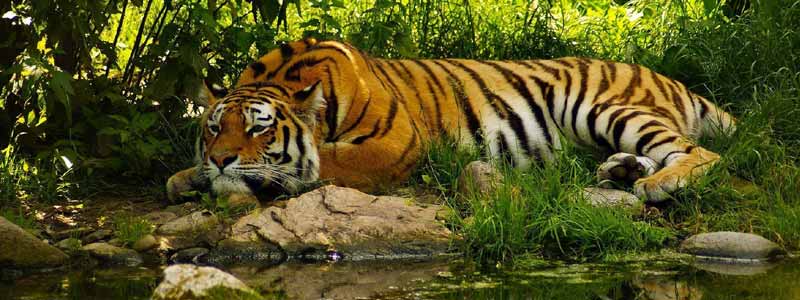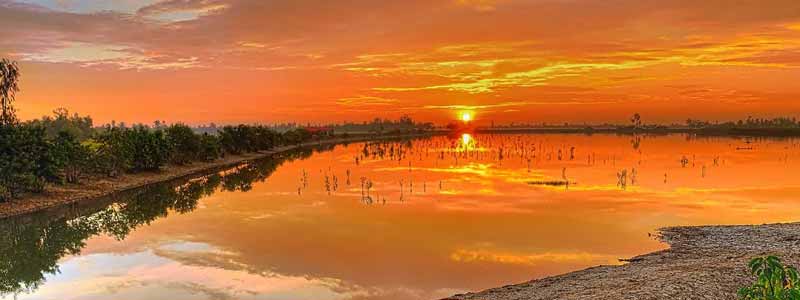Sundarbans National Park is a unique natural wonder of south Asia and the globe. The delta is spread over India and Bangladesh with an area of approximately 10,000 square kilometres and is enjoying the status of being largest halophytic mangrove forest in the world. It is a delta of the two great Indian River The Ganga and The Brahamputra which converges on the Bengal basin. The whole area is kingdom of the famous Royal Bengal Tigers.
The Sunderbans National Park is a tiger and biosphere reserve located in the Sunderbans delta in the state of West Bengal (India). The Sunderbans is named after the Sundari trees which are found in bulk in this area. The park was established as a national park on 4th May 1984 as earlier it was created as wildlife sanctuary in 1977, designated as the core area of Sunderbans Tiger Reserve.
Welcome to the land of tigers called “The Sunderbans National Park” extends in an area of approximately 1,355 Kms. The most preferable time to visit this park is in the month of September and May. If you visit in winter months you could see the sun-bathing on the river banks of amazing and powerful Royal Bengal Tigers. Apart from Bengal Tiger other chief wild life species present in this park are Macaques, Indian Grey Mongoose, Leopard Cats, Ridley Sea Turtle, Wild Boar, Jungle Cat, Fox, Flying Fox, Fishing Cats, Chital, Pangolin and a lot others.
Travelling to Sunderbans which is a place of incredible natural beauty and mangrove habitat, surely it will bring you close to the nature. Ample of things are there to make your trip memorable. Gliding crosswise the river in the boats takes you to the nature walk as you see varied cultural adventures and close encounter with the tigers has enough to make your eye-catching memories.
The serene ambiance and relaxed halo equips you with new energy, zeal and enthusiasm to your entire body parts. Away from the hustle and bustle of the city your mind and soul rests here in the lap of natural beauty. Encounter with the vibrant bees and chirping of birds will take you the unique natural wonder of the earth Sundarbans National Park.

History Sunderban Tiger Reserve
The land that acted as a shelter for the refugees in 13th century is today declared as a World Heritage Center and is the most renowned place for tiger conservation under the Tiger Project.
Sundarbans National Park was first notified as protected forest on 7 December 1878. Much of this was subsequently leased out by the government for purposes of cultivation, but the boundaries of the remaining protected forests were fixed under Notification No. 4457-For, dated 9 April 1926. Protected forests remaining in the Basirhat Division of the district were declared reserved forests on 9 August 1928 and those remaining in Namkhana Division on 29 May 1943.
The area of Sundarbans is established as a Tiger Reserve in the year of 1973. It was declared as a Wildlife Sanctuary in the year of 1977.
Sundarbans Wildlife Sanctuary was declared as a National Park in the year of 1984. In the year of 1987, Sundarbans was declared a World Heritage Site by the UNESCO. The park receives financial aid from the State Government as well as the MOEF under various Plan and Non-Plan Budgets. Additional funding is received under the Project Tiger from the Central Government. In 2001, a grant of US$20,000 was received as a preparatory assistance for promotion between India and Bangladesh from the World Heritage Fund.
The area congested with dense mangroves and swampy islands, being fitted for the tiger inhabitants and so the introduction of tiger project took place in the year 2004 as a scientific research project.
To continue the project in a more progressive way, the Save the Tiger Fund and the United States Fish and Wildlife Service generously donated funds to support the initial phase of research and to collect data on tiger ecology. It is estimated that there are now 400 Royal Bengal tigers and about 30,000 spotted deer in the area.

Zones – Sundarban National Park
- Sajnekhali Watch Tower:
It is also the Head Office of the Forest Department. Permission to enter the Sundarban Tiger Reserve is required to be obtained from here. The Mangrove Interpretation Centre, a Bono Bibi Temple as well as a Crocodile Park are located in the Sajnekhali Watch Tower complex. There is also a sweet water pond near the watchtower that is visited by different bird and animal species. Observation lines have been cut out that allow visitors to see wildlife from a distance. Bird watchers can see seven colourful species of the Kingfisher, White Bellied Sea Eagle, Plovers, Lapwings, Curfews, Whimbrel and Sandpipers.
- Sudhanyakhali Watch Tower:
Sudhanyakhali Watch Tower is one of the better watchtowers for wildlife sighting. There is a sweet water pond made by the forest department, where animals come to drink water. There are stretches of land behind the pond which are bereft of vegetation. Observation lines have been cut out that allow visitors to see wildlife from a distance. Axis deers, Wild Boars, Crocodiles and the elusive Royal Bengal Tiger can be seen from this watchtower.
- Dobanki/Dobanke Watch Tower:
Dobanki Watch Tower has a Canopy Walk that offers a unique vantage point to observe wildlife. This Canopy Walk is about half a kilometre long and at a height of about 20 ft from the ground. There is also a sweet water pond nearby that is visited by different bird and animal species. Observation lines have been cut out that allow visitors to see wildlife from a distance. Spotted deer as well as Brahminy Kites are very often sighted apart from the tigers.
- Jharkhali Watch Tower:
Jharkhali Watch Tower has a tiger rehabilitation centre and a butterfly park.
- Netidopani/Netidhopani Watch Tower:
Netidhopani Watch Tower offers visitors a view of the ruins of a 400 year old Shiva Temple. It is also believed that there is a road on the extreme right of the forest which was built by King Pratapaditya to guard the coastal area from the invading Mughals. It is now covered with earth. There is a sweet water pond nearby where animals come to drink water. Observation lines have been cut out that allow visitors to see wildlife from a distance.
- Burirdabri Watch Tower:
Burirdabri is renowned for its watchtower, a mud walk and mangrove cage trail that leads to the Raimongal Watch Tower. The ground fauna consisting of telescopic snails, varieties of crabs and mollusca can be observed closely during the mud walk. The walk culminates at a wooden watchtower that offers views of the Bangladesh Sundarbans.

Best Time To Visit Sundarbans
Winters are the best months and that is why September to March is the best time to visit the Sundarbans. The weather is excellent and apart from seeing the animals, you can also spot a few migratory birds. The summers are hot and keep the inhabitants hidden deep inside the forest area while the monsoons with its generous showers make it impossible to travel for the tourists who visit this place.
Visiting Sundarbans During Summer (April to June):
From April to June, the weather is extremely hot in the Sundarbans and the humidity is on top with the high temperature that ranges from 30 to 42 degrees Celsius. The hot weather is very uncomfortable for tourists, thus it is not an ideal time to visit Sundarbans National Park.
Visiting Sundarbans During Monsoon (July to September):
From July to September, the monsoon season brings heavy rains in the Sundarbans making the water level reaches beyond the normal level which makes the boat safari a risky affair. Though the monsoon season brings much-needed relief for the wild flora and fauna after the summer this season is also not an ideal time to visit Sundarbans.
Visiting Sundarbans During Winter (October to March):
It is the best time to visit the Sundarbans due to the pleasant weather from October to March. Except for a few days of very cold weather, the entire duration of the above time interval is having a lovely weather with moderate temperature which ranges from 10 to 30 degrees Celsius. You will enjoy the flora and fauna of the Sundarbans National Park and the beauty of the raw forest without any hassle.
How to Reach Sundarbans
By Air – Nearest airport is Kolkata airport, about 140 Km from the Sundarbans National Park. Kolkata airport is well connected by road network to Sundarbans National Park.
By Rail – Nearest railway station is Canning railway station, about 30 Km from the Sundarbans National Park. Canning railway station is well connected by road network to Sundarbans National Park.
By Road – Sundarbans National Park is well connected to Major Cities and Places by road network. There are a number of government and privately operated vehicles that go to Sundarbans National Park at frequent intervals.








